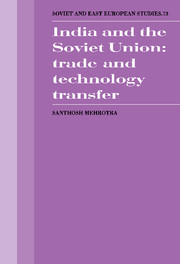5 - The collaboration agreements
from PART II
Published online by Cambridge University Press: 04 August 2010
Summary
Having discussed financial flows to India from the USSR, we can now set out the criteria adopted in the latter half of this chapter and in chapter 6 to evaluate the effectiveness of technology transfer from the Soviet Union to India and the degree to which an independent technological capability has been developed in the sectors recipient of Soviet technology.
Methodology for evaluating technology transfer
An independent technological capability implies the capability to carry out the following six functions in relation to the setting up and running of a project. The first two categories relate to the setting up and the last four to the running of a plant:
Pre-investment studies. The first step is a feasibility study, technical and economic (which initially means the commercial feasibility). This involves expert assessment of the technical requirements of the project (including choice of technique) and careful estimation of the costs and benefits to the national economy, involving, inter alia, a detailed market survey.
Project execution. This includes the following sub-categories of technological capabilities: basic engineering; detailed engineering; equipment procurement; erection of equipment; commissioning the plant.
Process engineering. Process engineering skills are manifested in: trouble-shooting; substitution of raw materials; capital goods stretching (by extending its life, raising its speed); process innovation.
Product engineering. These skills imply the capability to: adapt a product to the consumer's needs; improve the product; develop a new product.
[…]
- Type
- Chapter
- Information
- India and the Soviet UnionTrade and Technology Transfer, pp. 74 - 87Publisher: Cambridge University PressPrint publication year: 1991



